
|

Feature Article...
Screech Owling 101
Text and Photography Copyright Dr. Peter May
All rights reserved.
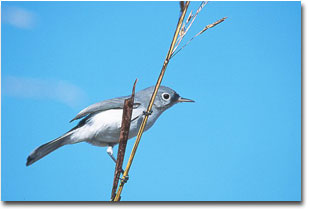 Many species of birds, particularly among the passerines, engage in a type of anti-predator behavior loosely known as mobbing. Because these behaviors can often be elicited by auditory cues even in the absence of a real predator, they provide the bird photographer with a tool to obtain photographic opportunities that would be virtually impossible in any other way. Birdwatchers have known about and used owl vocalizations for years to attract and view shy birds. I believe that most people will be able to make better use of this technique if they understand something of the natural history and adaptive significance of the behavior, so I'll begin with a brief overview of mobbing behavior, and follow that with specific hints and suggestions for using this behavior to increase your bird photography possibilities.
Many species of birds, particularly among the passerines, engage in a type of anti-predator behavior loosely known as mobbing. Because these behaviors can often be elicited by auditory cues even in the absence of a real predator, they provide the bird photographer with a tool to obtain photographic opportunities that would be virtually impossible in any other way. Birdwatchers have known about and used owl vocalizations for years to attract and view shy birds. I believe that most people will be able to make better use of this technique if they understand something of the natural history and adaptive significance of the behavior, so I'll begin with a brief overview of mobbing behavior, and follow that with specific hints and suggestions for using this behavior to increase your bird photography possibilities.
Mobbing Behavior
This term refers to a variety of behaviors in which a prey species locates and approaches, and in some cases physically attacks, a potential predator, particularly when the predator is not an immediate threat. Whether it be crows harassing a red-tailed hawk, a mockingbird dive bombing the neighborhood cat, or a flock of passerines flying hundreds of yards to seek out a vocalizing owl, all presumably function somehow to decrease the probability that the predator will make a meal out of the mobber (or his relatives) at some future date.
Many species of passerine birds (and some non-passerines, such as woodpeckers and hummingbirds) mob owls found in the open during the day. The urge to locate and somehow interfere with the predator is so strong that many species will respond to owl vocalizations alone, and travel significant distances to find the calling owl. Once located, the mobbing species may show a variety of different behaviors, ranging from simple approach to various distances (many warblers), approach with vocalizations (wrens, titmice, chickadees), and direct attack. Ornithologists have never resolved exactly what the benefit of mobbing is to the species involved, but hypotheses suggest several possible functions, including a) injury of the predator (rare), b) driving the predator away, and presumably reducing the chances of future attack, and c) education of naïve, young birds on how to recognize specific predators. Key to most mobbing behaviors, though, is that they occur in response to predators that are not an immediate threat. Owls, for example, are primarily nocturnal, ambush hunters. They are not capable of attacking and capturing small, agile passerines that are aware of their presence and are flitting actively all around them. Predators that are an immediate threat (Accipiter hawks, for example), are treated with an entirely different set of behaviors and vocalizations than are owls (retreat to cover, crypsis, non-localizable alarm calls). Because mobbing behavior confers no immediate benefits to the mobbers, it seems often to be a relatively low-priority behavior that the mobbing species engage in only when other, more pressing biological demands such as hunger, mate attraction, or taking care of offspring do not require the immediate attention of the birds. This is probably why response to screech owl vocalizations is so variable and unpredictable, and of such short duration when it does occur.
Ethical Considerations
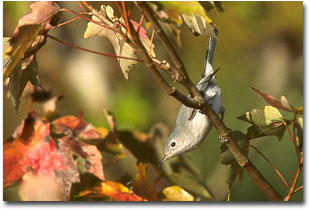
Some national parks and other wildlife refuges ban the use of any recorded vocalizations to attract birds, so be aware of the regulations wherever you are. Overuse of tape playback to attract birds can be detrimental to the survival and reproduction of some species by preventing them from devoting full attention to other biological demands, such as feeding their offspring. However, I don't think this is a concern when using screech owl tapes. Playback of the species-specific territorial song of many species during their breeding season will attract territorial males to the source of playback for up to hours at a time, if the person playing the tape is persistent. Response to screech owl tapes is entirely different - the birds often don't respond at all, and when they do, even the most vigorous responses wane and disappear within 10 minutes or so, as the birds drift away to resume their other activities once they discover no predator producing the vocalizations. It is virtually impossible to immediately attract those birds again. Essentially, the behavior of the birds regulates the effectiveness and impact of using owl tapes.
One negative impact that can result from use of owl tapes is attraction of other predatory birds to the mobbing flock. On probably half a dozen occasions, I have seen sharp-shinned hawks burst into the middle of a mobbing flock and attempt to pick one off. Most of these attacks have been unsuccessful, but be aware that you are sometimes producing a concentration of prey that can attract predators. I've seen more birds killed by hawks at bird feeders than in mobbing flocks, though. It's a dangerous world out there for a dickey bird.
Procedures
The equipment used can be as simple or sophisticated as you like. Outdoor suppliers (such as L.L. Rue, Cabela's) provide high-fidelity playback equipment with amplified speakers to increase sound quality and broadcast range, but you can obtain excellent results with a small, handheld cassette recorder. I use a portable recorder made by GE that is about the size of a field guide and sells for $20 at any Wal-Mart or K-Mart. When I call from a car, I plug it into a small, amplified speaker from Radio Shack (~$15) that runs on 4 C batteries. The few microcassette recorders I've tried have had insufficient volume output to be effective.
The tape should contain at least 5 minutes of continuous owl vocalization. You don't want to have to stop and rewind the tape in the middle of a mobbing episode, as activity levels are high and photography of the frenetic birds will require all of your attention. Endless loop tapes are ideal. A 30 second loop tape will contain 2 to 3 bouts of vocalizations recorded from a typical bird song record or CD. The vocalizations can be separated by slight pauses or more or less continuous. It doesn't seem to affect attractiveness. Sound quality doesn't seem particularly critical either; tapes recorded through the built-in microphone of a portable cassette recorder work fine. Try to record the tape at as high a volume as possible without distortion to maximize auditory range.
Eastern Screech Owls have two primary vocalizations, a descending trill and a monotonic trill. Both are present on some commercially available bird call recordings. The descending trill is thought to be a territorial defense call used mainly in late summer and fall, while the monotonic trill is considered a nest-site advertisement and family contact call, and is heard more in early spring and summer. I have used each of these calls alone, and interspersed, and I seem to get better response when both calls are present. All variants work well, however.
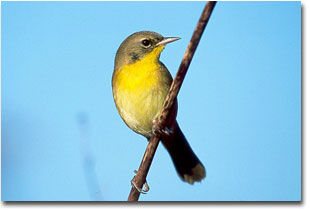
Some mobbing species are highly vocal, and produce similar sounding buzzy, scolding calls (wrens, vireos, chickadees, titmice, kinglets, gnatcatchers). The presence of these alarm calls seems to enhance attraction of other species to the mobbing flock. These sounds are easily imitated by sucking air through pursed lips on the back of your hand (squeaking) or making pssssh sounds (pishing). Both techniques are used by birders to attract birds, and will work well even without owl vocalizations. Many birding supply companies sell small mechanical squeakers of wood and pewter that produce a variety of chirping and squeaking sounds. These sounds will also sometimes bring birds in closer than they would come with the owl tape alone.
The use of taxidermic mounts of screech owls or even simple model decoys may enhance photographic opportunities even more, as it would give the birds a specific focus for their attention. I've never tried either, but would encourage anyone interested to pursue it report on their results.
Some tips for maximizing your photographic opportunities with owl tapes.
- Owl tapes won't find birds for you. You have to do that first, and the owl tape will then bring them in closer than you would be able to approach them otherwise. Photographers with good birding skills will have far better success using owl tapes than those who know nothing about looking for birds. Randomly playing tapes in appropriate habitat may bring in birds occasionally, but it's far more effective to locate birds visually or aurally, and then broadcast the calls. Listen for contact notes or chip notes, or for specific calls of species that are frequent mobbers, such as titmice, chickadees, or wrens.
- Mixed species flocks of passerines respond particularly well. In temperate North America, most species of small woodland birds spend the fall and winter foraging in loosely organized flocks of up to 10 or more different species. Species engaging in flocking include chickadees, titmice, wrens, woodpeckers, nuthatches, warblers, kinglets, gnatcatchers, vireos, and some others. As mobbing is primarily a group phenomenon, playing tapes to these flocks will usually produce a stronger response than playing to single individuals.
- There is strong seasonal variation in responsiveness. In my experience, owl tapes are least effective during and immediately preceding the breeding season. Beginning in late winter or early spring when males are establishing territories, through the period when parents are feeding young in the nest, I rarely get much response at all. Once young birds fledge and start following parents around, response increases regularly, peaking in fall-early winter. I think this has something to do with the idea that mobbing is a low-priority behavior, and is abandoned when there are more pressing demands.
- Time of day and weather conditions influence response. Cold, windy, rainy weather tends to suppress mobbing activity. Using owl tapes in the middle of winter can be very productive or a total waste of time. This probably also relates to priority of behavior according to physiological need - if birds are energy-stressed, they will spend most of their time foraging rather than responding to a low-risk predator. Strongest responses at most times of year are usually in the morning (sunrise to 2-3 hours later) and late afternoon (2-3 hours before sunset). Fortunately, this coincides with the quality of light for photography. Mid-day response is often poor, except on some mild, overcast days. Diffuse mid-day light can often be great for bringing out texture in plumage as well.
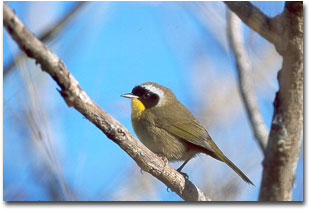
- Choose your specific location for playback carefully. If all you want to do is attract birds for viewing, you can use playback anywhere, but if you'd like to photograph some of the birds, you must position yourself precisely before beginning playback. Habitat edges or ecotones are ideal, and often provide the best natural light. Choose an area with some dense cover, and a few exposed perches in direct light. Overhead canopy usually reduces your photographic opportunities, as most birds will tend to sit high above your head and scold you if there are perches available. Don't choose a site too far from wooded cover, though, as most of the birds that are best attracted are found in forests or woodland edges. I haven't had a lot of luck in open habitats such as fields or marshes, but that could be due to lack of cover and perches for the birds to use. Distracting backgrounds are always a problem, but pretty much unavoidable - if no dense cover is nearby, most birds won't approach. The best you can hope for is that birds will concentrate in the dense cover and occasionally will pop briefly onto one of the exposed, well-lit perches. Your car makes a great blind. You can increase its effectiveness by draping a piece of camouflage netting across the driver's window. When not in a car, camouflage netting can be draped around the photographer and tripod/camera to form a quickie blind. Setting up a regular blind at each spot you wish to play owl tapes is probably not very efficient - you will usually have no more than 10 minutes of activity (and often none) at each site before the birds lose interest and leave.
- Focus attention on a few spots. Find the best-lit, most photogenic perches, and concentrate on them. Pre-focus, meter, and set the exposure. I prefer to use manual metering and settings, spot metering on a tree trunk in light similar to that of the perches where (I hope) the birds will land. Automatic metering is easily fooled by a bird in partial shade in front of a well-lit background, or by a bird in full sun in front of dark, shaded background. Decide before beginning playback what shots/perches you are going to attempt. You will probably have no more than 5 seconds to photograph most birds in any one spot because of their high activity levels, so attempting to cover all of the area around you usually results in lots of panning and focusing without ever getting a shot off.
- Don't start playback until you're ready to shoot. The first birds sometimes pop into view within seconds after the tape starts, and just as quickly pop out of view. Be ready.
- Minimize your movements. Most species are extremely alert and wary when mobbing (sounds like a paradox, but it's true), and will rapidly dart into thick cover if they see you moving quickly. If you have to change positions, do so slowly and inconspicuously.
- If you see or hear no response in 5 minutes, give up. Mobbing birds are often heard first from some distance away as they locate and track down the source of the call. If you hear a lot of chipping or calling in the distance, keep playing. Those birds will probably continue to approach. If not, try elsewhere. Most mobbing flocks, even with the most intense response and activity, will break up and leave within 10 minutes. Those birds can't be re-attracted immediately. Try elsewhere at least a couple hundred meters away, where you will be within hearing range of new birds. Screech owling works best when you move frequently and try lots of locations, and doing it from a car is an ideal method.
- Expect big differences between species. Some species are very active, vocal, and bold, and will often approach to within 5 or 10 feet. Others will hang back quietly on the periphery of the flock and never approach. Some species are persistent, and will hang around for several minutes, while others will come in quickly, and just as quickly fly off. Expect to be frustrated and disappointed as the species you most want to photograph never give you the shot you're looking for, while the species you have tons of photographs of (MYRTLE WARBLERS, BLUE-GRAY GNATCATCHERS!!!) perch on the front of your lens every time you play the tape. Even with the most common species, good photographic opportunities are infrequent and extremely ephemeral. It's not unusual to have a flock of 20-30 birds hopping all around you for 5 minutes and never have one land in a photogenic spot. There are some days when I use the technique for several hours at a time and never take one photograph.
- Be persistent. It won't work every time, but it will work amazingly well on some occasions.
Caveat - My experience is exclusively in eastern N. America, where the screech owl is a common and widespread resident. From reading the ornithological literature, however, it seems that mobbing behaviors by small birds, especially in response to owls, is widespread if not universal. My guess is that vocalizations of small to medium sized owls that are native to other areas of the world will elicit similar behavior among the birds there.
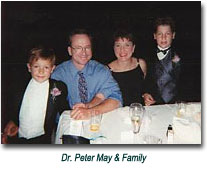 Dr. Peter May is a professor of biology at Stetson University in DeLand, Florida.
An avid birder since his teenager years (before they were called "birders"), an entomologist/lepidopterist since about 1977 and a herpetologist since
1992, Dr. May resides in DeLand, Florida with his wife Deborah and their two sons, Sam and Benji.
Dr. Peter May is a professor of biology at Stetson University in DeLand, Florida.
An avid birder since his teenager years (before they were called "birders"), an entomologist/lepidopterist since about 1977 and a herpetologist since
1992, Dr. May resides in DeLand, Florida with his wife Deborah and their two sons, Sam and Benji.
Learn more about Dr. May and view his excellent portfolio of nature and wildlife photography at his personal web site.
|



 Many species of birds, particularly among the passerines, engage in a type of anti-predator behavior loosely known as mobbing. Because these behaviors can often be elicited by auditory cues even in the absence of a real predator, they provide the bird photographer with a tool to obtain photographic opportunities that would be virtually impossible in any other way. Birdwatchers have known about and used owl vocalizations for years to attract and view shy birds. I believe that most people will be able to make better use of this technique if they understand something of the natural history and adaptive significance of the behavior, so I'll begin with a brief overview of mobbing behavior, and follow that with specific hints and suggestions for using this behavior to increase your bird photography possibilities.
Many species of birds, particularly among the passerines, engage in a type of anti-predator behavior loosely known as mobbing. Because these behaviors can often be elicited by auditory cues even in the absence of a real predator, they provide the bird photographer with a tool to obtain photographic opportunities that would be virtually impossible in any other way. Birdwatchers have known about and used owl vocalizations for years to attract and view shy birds. I believe that most people will be able to make better use of this technique if they understand something of the natural history and adaptive significance of the behavior, so I'll begin with a brief overview of mobbing behavior, and follow that with specific hints and suggestions for using this behavior to increase your bird photography possibilities.
 Dr. Peter May is a professor of biology at Stetson University in DeLand, Florida.
An avid birder since his teenager years (before they were called "birders"), an entomologist/lepidopterist since about 1977 and a herpetologist since
1992, Dr. May resides in DeLand, Florida with his wife Deborah and their two sons, Sam and Benji.
Dr. Peter May is a professor of biology at Stetson University in DeLand, Florida.
An avid birder since his teenager years (before they were called "birders"), an entomologist/lepidopterist since about 1977 and a herpetologist since
1992, Dr. May resides in DeLand, Florida with his wife Deborah and their two sons, Sam and Benji.